Audio for IMAG’s ‘Man Playing Flute’ now live on Otocast
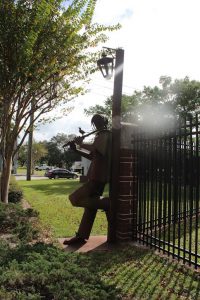 The audio for the Edgardo Carmona sculpture Duo Sinfonica or Man Playing Flute is now live on Otocast. Man Playing Flute is one of two Carmona sculptures that have been moved to IMAG History & Science Center in the City’s third ward. Man Playing Flute leans against a stone pillar that anchors the wrought iron fence running along Martin Luther King, Jr. Boulevard.
The audio for the Edgardo Carmona sculpture Duo Sinfonica or Man Playing Flute is now live on Otocast. Man Playing Flute is one of two Carmona sculptures that have been moved to IMAG History & Science Center in the City’s third ward. Man Playing Flute leans against a stone pillar that anchors the wrought iron fence running along Martin Luther King, Jr. Boulevard.
With Man Playing Flute, sculptor Edgardo Carmona captures a moment in time during which a flutist and his beautiful tunes attracts a chirping bird to sing in tandem with him. This artwork was positioned to look across the street towards McCollum Hall on purpose. That’s because from 1938 through the ‘60s, McCollum Hall was a stop along the Chitlin’ Circuit that hosted 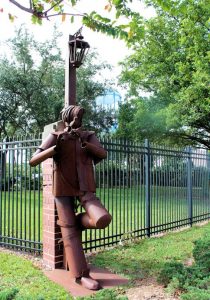 such iconic and internationally-renowned musicians as Count Basie, Louis Armstrong, B.B. King, Lionel Hampton, Otis Redding, Lucky Milliner and Duke Ellington and his orchestra. The new audio tells that story, which is also reproduced on the 17-panel Buck’s Backyard Mural that adorns the wall behind McCollum Hall.
such iconic and internationally-renowned musicians as Count Basie, Louis Armstrong, B.B. King, Lionel Hampton, Otis Redding, Lucky Milliner and Duke Ellington and his orchestra. The new audio tells that story, which is also reproduced on the 17-panel Buck’s Backyard Mural that adorns the wall behind McCollum Hall.
When you listen to the audio, you’ll hear the new voice of Fort Myers public art, Bill Taylor. A long-standing member of the City of Fort Myers Public Art Committee, Bill Taylor is best known in Southwest Florida as a producer, director, actor and founder of Theatre Conspiracy at the Alliance for the Arts.
Since founding 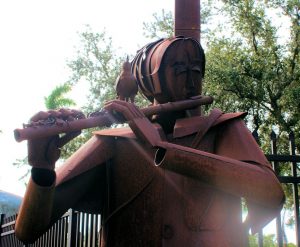 the latter company in 1984, Bill has produced more than 120 shows, directed 40 productions and performed in over 50 others including three one-man shows, Sex, Drugs & Rock and Roll, Barrymore and Tru. His favorite shows include A Tuna Christmas, The Katy and Mo Show, and whatever play he is working on currently.
the latter company in 1984, Bill has produced more than 120 shows, directed 40 productions and performed in over 50 others including three one-man shows, Sex, Drugs & Rock and Roll, Barrymore and Tru. His favorite shows include A Tuna Christmas, The Katy and Mo Show, and whatever play he is working on currently.
Among the many initiatives Taylor has launched at Theatre Conspiracy are its perennial  New Play Contest, an emphasis on productions written by female playwrights and providing strong female characters, and programming that provides opportunities for area actors of color and discourse on the Black experience in America (in shows like George C. Wolff’s A Colored Museum, Lorraine Hansberry’s A Raisin in the Sun, August Wilson’s King Hedley II, Joe Wilson’s Come and Gone, Seven Guitars and Ma Rainey’s Black Bottom,
New Play Contest, an emphasis on productions written by female playwrights and providing strong female characters, and programming that provides opportunities for area actors of color and discourse on the Black experience in America (in shows like George C. Wolff’s A Colored Museum, Lorraine Hansberry’s A Raisin in the Sun, August Wilson’s King Hedley II, Joe Wilson’s Come and Gone, Seven Guitars and Ma Rainey’s Black Bottom, 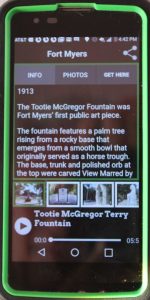 Lydia Diamond’s The Bluest Eye and Ntozake Shange’s For Colored Girls Who Have Considered Suicide When the Rainbow is Enuf).
Lydia Diamond’s The Bluest Eye and Ntozake Shange’s For Colored Girls Who Have Considered Suicide When the Rainbow is Enuf).
If you haven’t yet used Otocast yet, pull out your smartphone and go to your app store right now. When you land there, type Otocast in the search bar and then hit download. It’s free!
The app works with geo-mapping, which means that when you tap on the green Otocast icon, the app will automatically call up the Fort Myers Guide.
Tap on the Guide and you’ll see an aerial map of Fort Myers that displays a number of green pins. Those pins signify the location of most of the public artworks that are interspersed throughout Fort Myers.
Notice 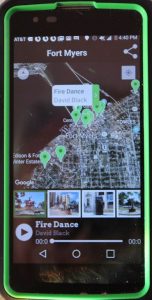 the banner that runs along the bottom of your screen. It contains thumbnail photographs of the particular artworks identified by those green pins. Tap on any one of them and it will take you to written information about the artwork; historic, installation and other photos; and an audio like the one that Bill Taylor just recorded for Man Playing Flute or the other IMAG art piece, Boy Fishing from a Bucket.
the banner that runs along the bottom of your screen. It contains thumbnail photographs of the particular artworks identified by those green pins. Tap on any one of them and it will take you to written information about the artwork; historic, installation and other photos; and an audio like the one that Bill Taylor just recorded for Man Playing Flute or the other IMAG art piece, Boy Fishing from a Bucket.
At present, 30 of the City’s 41 outdoor public artworks are included in the Fort Myers Guide. Work is under way to not only add the other eleven, but more than 30 historic points of interest located throughout the City.
Don’t just use Otocast to learn more about the artworks see about town. Be sure to share Otocast with everyone you know. It’s a real conversation starter.
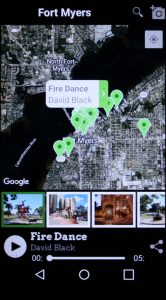 September 23, 2022.
September 23, 2022.
RELATED POSTS.
- Audio for IMAG’s ‘Boy Fishing from Bucket’ now live on Otocast
- Audio for Franklin Shops’ ‘Two Drunks on a Bench’ now live of Otocast
- Audio for Collaboratory’s ‘Ribbon Routine’ now live
- Garden Council past president Kay Holloway records Otocast audio for 1880 statue ‘Lorelei’
- Edison Ford Executive VP and author Mike Cosden records Otocast audio for ‘Uncommon Friends’
- Freelance writer, author and SWFHS President Glenn Miller records Otocast audio on Wes Nott
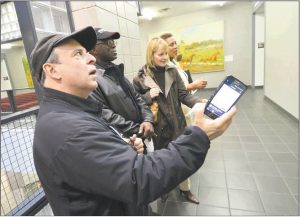 Civil rights activist and musical instructor Reginald Billups records Otocast audio for USCT 2nd Regiment Monument
Civil rights activist and musical instructor Reginald Billups records Otocast audio for USCT 2nd Regiment Monument- River District Alliance Director and author Jared Beck records Otocast audio for Tootie McGregor Fountain
- Albert Paley records Otocast audio for his Riviera-St. Tropez sculpture, ‘Naiad’
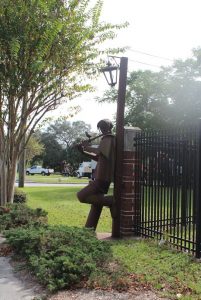 Author-historian Gerri Reaves records Otocast audio for ‘The Spirit of Fort Myers’
Author-historian Gerri Reaves records Otocast audio for ‘The Spirit of Fort Myers’- Muralist Barbara Jo Revelle records Otocast audio that tells all about downtown ceramic tile mural
- Maryland artist Cheryl Foster records Otocast audio for her Clemente Park sculpture
- IMAG History & Science Director Matt Johnson records Otocast audio














 Tom Hall is both an amateur artist and aspiring novelist who writes art quest thrillers. He is in the final stages of completing his debut novel titled "Art Detective," a story that fictionalizes the discovery of the fabled billion-dollar Impressionist collection of Parisian art dealer Josse Bernheim-Jeune, thought by many to have perished during World War II when the collection's hiding place, Castle de Rastignac in southern France, was destroyed by the Wehrmacht in reprisal for attacks made by members of the Resistance operating in the area. A former tax attorney, Tom holds a bachelor's degree as well as both a juris doctorate and masters of laws in taxation from the University of Florida. Tom lives in Estero, Florida with his fiancee, Connie, and their four cats.
Tom Hall is both an amateur artist and aspiring novelist who writes art quest thrillers. He is in the final stages of completing his debut novel titled "Art Detective," a story that fictionalizes the discovery of the fabled billion-dollar Impressionist collection of Parisian art dealer Josse Bernheim-Jeune, thought by many to have perished during World War II when the collection's hiding place, Castle de Rastignac in southern France, was destroyed by the Wehrmacht in reprisal for attacks made by members of the Resistance operating in the area. A former tax attorney, Tom holds a bachelor's degree as well as both a juris doctorate and masters of laws in taxation from the University of Florida. Tom lives in Estero, Florida with his fiancee, Connie, and their four cats.